Categories: How does it work, Microcontroller circuits
Number of views: 32508
Comments on the article: 0
Radio Frequency Identification (RFID): Operation and Application
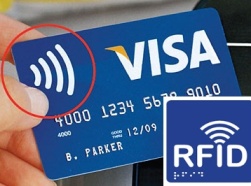 RFID (Radio Frequency Identification) is a way to ensure the storage and transmission of information from a convenient label carrier to the desired location using special devices. Such identifier tags make it easier to recognize various objects: goods in the store, mobile vehicles during transportation, help determine their location, can identify people and animals, not to mention the wide possibilities of identifying documents and property.
RFID (Radio Frequency Identification) is a way to ensure the storage and transmission of information from a convenient label carrier to the desired location using special devices. Such identifier tags make it easier to recognize various objects: goods in the store, mobile vehicles during transportation, help determine their location, can identify people and animals, not to mention the wide possibilities of identifying documents and property.
What is an RFID tag
The electromagnetic wave received by the RFID tag from the antenna activates it, and it becomes possible to write data to the tag and read data from the tag. The antenna thus serves as a multifunctional communication channel between the transceiver and the tag, which fully ensures the processes of data transmission and reception.
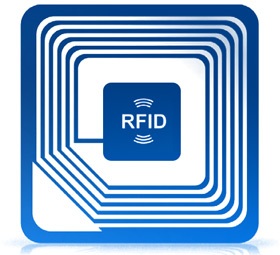
Antennas of various shapes and sizes can be embedded in scanners, gates, turnstiles, in different means for working with RFID tags, in order to provide access to information stored in the tags of goods, objects, people, vehicles, etc. - in total, which moves through the range of the scanner antenna and has an RFID tag on it.
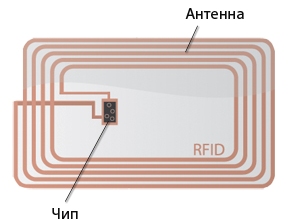
The antenna can continuously work and constantly read tags in large numbers, all the time interrogating them, or it can be turned on for a while by a signal from the operator. An antenna with a transceiver and a decoder are often located in one common housing, so that the signal from the antenna would be immediately demodulated, decrypted and transmitted through a standard interface to a PC for further processing of the received data.
The label itself usually contains an antenna, receiver, transmitter, and memory for storing data. The label receives energy from the radio signal of the reader’s antenna or from its own power source, after receiving an external signal, the label responds with its own signal, which contains certain identification information. So RFID tags are a kind of label, only smarter.

Writing information to an RFID tag
Information can be recorded on a tag in various ways, depending on the design of the tag. So, RFID tags can be of the following types:
-
R / O - tags only for reading (Read Only), when the data are entered at the stage of manufacturing tags, and no longer change;
-
WORM - tags for one-time recording and subsequent multiple reading (Write Once Read Many), no data are entered into such tags in production, information is recorded by the user once, then can be read many times;
-
R / W - tags for repeated writing and subsequent repeated reading of information (Read / Write).
Passive and Active RFID Tags
A passive RFID tag is able to work without its own energy source, it receives energy for power only from the scanner signal. Such tags are smaller in size than active ones, lighter in weight, cheaper to manufacture, and have an unlimited service life - this is their main advantage.
A conditional disadvantage of a passive RFID tag is that a reader of sufficiently high power is required. The active tag is distinguished by the presence of a built-in battery or by the need for an attached battery.
Such tags interact with the scanner antenna at a greater distance than passive tags, since they require less power from the antenna during operation - this is the main advantage of active tags, they differ in read range 2-3 times greater than passive tags, and an active tag can move at high speed through the scanner’s coverage area, and still have time to work.
Both passive and active labels for write / read capabilities, single / multiple, - can vary widely regardless of the power method.
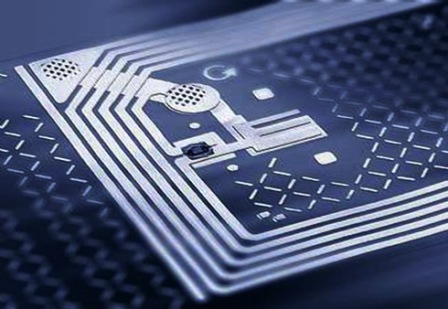
RFID tag device
The receiver, transmitter, antenna and memory unit are the main parts of the RFID tag. Everything except the antenna is placed in the case of a small microcircuit - a chip, so it may seem that the mark consists only of a multi-turn antenna and a chip. In active labels there is another part - a power source, a lithium battery for example.
Benefits of RFID Tags over Graphic Identifiers
The barcode is printed only once at the production and packaging stage, and the information on the RFID tag can be not only completely changed, but also supplemented. Tags can be read immediately in large numbers thanks to the anti-collosion mechanism, which is difficult to achieve for graphic codes.
Despite the fact that matrix codes can accommodate relatively large amounts of data, they require large areas for applying codes, for example, to write 50 bytes with a barcode, an A4 sheet is required, while an RFID tag with a chip of only 1 square centimeter is easy will hold 1000 bytes.
Writing to the label is fast enough, and graphic codes must first be typed, then printed and pasted, and even to preserve the integrity of the image.
With RFID identifiers, everything is simpler, it’s enough to “implant” the label into the package at the production stage (not necessarily from the outside), then write the data in a non-contact way, and the label will be eternal (at least 1,000,000 interactions with the scanner antenna), the label hidden inside the product is not scary dirt or dust.
In addition, the data recorded on the label, in whole or in part, can be protected from reading or overwriting with a password if necessary - this is a reliable way to protect against fakes. At the same time, reading occurs at any position of the mark in the scanner coverage area - this is more convenient than the graphic code that needs to be brought evenly to the scanner.
Frequency according to application
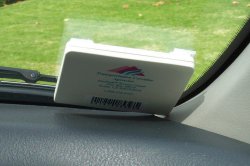 Where a high reading speed is required, for example, for monitoring cars in motion, railroad cars, in waste collection systems, high frequencies of 850-950 MHz and 2.4-5 GHz are used. High-frequency scanners are mounted in gates or barriers, and an RFID tag (transponder) is installed, for example, on the windshield of a car. The range of interaction between the tag and the scanner is from 4 to 8 meters, which creates favorable conditions for people, since the reader is located out of their reach.
Where a high reading speed is required, for example, for monitoring cars in motion, railroad cars, in waste collection systems, high frequencies of 850-950 MHz and 2.4-5 GHz are used. High-frequency scanners are mounted in gates or barriers, and an RFID tag (transponder) is installed, for example, on the windshield of a car. The range of interaction between the tag and the scanner is from 4 to 8 meters, which creates favorable conditions for people, since the reader is located out of their reach.
Currently, the mid-frequency range of 10-15 MHz is very popular. It is used in transport and other similar applications where work with rewritable cards, smart cards, etc. is required. Many current smart cards work just like mid-wave RFID tags.
The low frequency range 100-500 KHz operates at a small distance between the scanner and the object, not more than 50 cm, sometimes less than 10 cm.
A large antenna compensates for the short range, but interference from high-voltage lines, computers, and even energy-saving lamps can interfere with the system. But still, in many access control systems (warehouses, walk-throughs), low frequencies are used to work with contactless RFID cards. In addition, the low frequency range is used for non-contact identification of animals and metal objects, such as beer kegs.
See also:
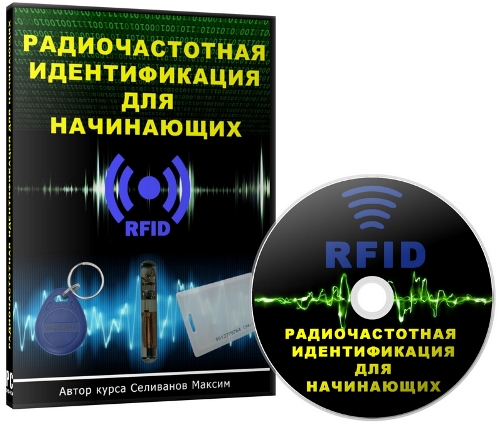
24 videos with a total duration of 11 hours 17 minutes.
The first part describes what radio frequency identification is generally about, on what physical laws data transmission is based, what standards exist, and where cards of various standards are most often used. Types of cards, their internal structure, scope. Ways of interaction between cards and readers.
The second part is devoted to the review of EM-Marine standard cards. Card execution form factor. Areas of use. Protocol data transfer from the card. ID code storage format.Card basics. The reader circuit is also considered here, recommendations will be given on the assembly and configuration of the reader. And finally, the algorithm for transmitting the card identification code is examined in detail.
The third part of the video is devoted to Mifare cards. Appearance of cards, scope of use. The module is based on the specialized chip MFRC522. Connecting the module to the microcontroller. Analysis of the library for working with the module. A detailed analysis of working with cards of the Mifare Ultralight and Mifare Classic standard.
See also at i.electricianexp.com
:
